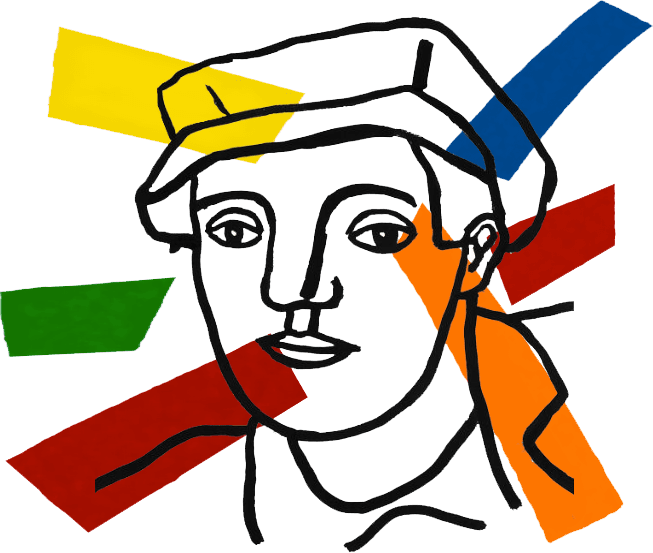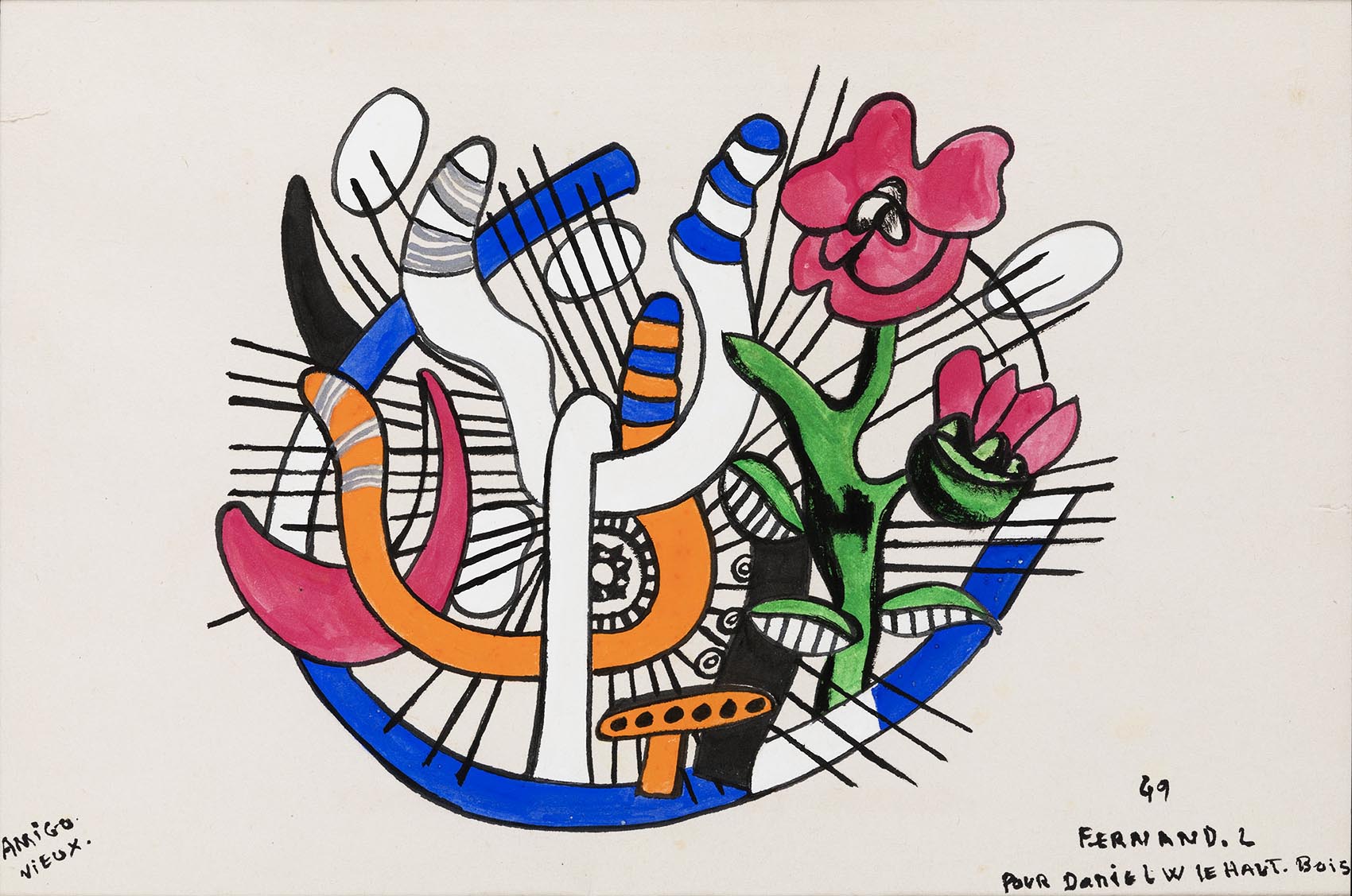Fernand Léger returned to France in December 1945 after a five year exile in the United States. Briefly before his departure, he sent to Jean-Richard Bloch a telegram informing him of his enrollment in the French Communist Party.
Léger has a wealth of keepsakes from his stay in the United States: in his luggage 57 canvases and 125 works on paper, of which many are early stages of great compositions, such as La Partie de Campagne which is a continuation of the Cyclistes, a recurrent theme during his American years.
In Paris, he painted Adieu New York. This is a true break: his membership in the Communist Party prevented him in the McCarthy times from obtaining a visa. He will never return to the United States.
In any event, it is the American artists who come to him: Ellsworth Kelly, Sam Francis and Kenneth Nolan will spend time in his academy. The master speaks perfect English.
This may seem paradoxical: in hindsight, one can suppose that his membership results less from ideological convictions then from Nadia Léger, an ardent communist who wants to bring the master ino the post-war intellectual trends.
Fernand Léger is a profoundly generous and sensitive person. His art aims to be popular and accessible to all. He has a genuine social interest, aspiring to share culture and loyal friendship. His deep roots in the country in his property in Lisores which is a haven of inspiration and joyous friendship (Blaise Cendras, the brothers Fratellini, Le Corbusier, Daniel Wallard…) keep him from being caught in an ideological trap. He always refused to produce propaganda art.
Pourtant le Parti communiste lut dans les Constructeurs une réponse satisfaisante à ses injonctions faites aux artistes de pratiquer un art qui soutienne les valeurs de la classe ouvrière. Quelques toiles furent présentées dans une des cantines du comité d’entreprise des usines Renault à Boulogne-Billancourt. Mais à sa grande déception, elles ne furent pas comprises. Assis à table au milieu des ouvriers, il écoute leurs réactions : « Regarde-moi ses mains… Impossible de travailler avec des mains pareilles ! ». La CGT refusera même le don du grand tableau des Constructeurs !
C’est la couverture du magazine « URSS en construction » de novembre 1949, montrant la construction d’un immeuble de la place Smolensk de Moscou qui est l’élément déclencheur de la série des Constructeurs. Une intuition qu’il avait déjà en lui avec la construction des gratte-ciel américains ou en découvrant sur la route de Lisores les grands pylônes électriques installés par les allemands.
Les Constructeurs resteront comme l’œuvre contemporaine où l’expression sociale du travail est la plus plastiquement réussie, la plus puissante et monumentale.
Et c’est l’Art Institute of Chicago qui organisera la dernière rétrospective montrée du vivant de l’artiste. Voilà de quoi fâcher encore un peu plus ces amis communistes à l’anti-américanisme virulent, Aragon en tête, lui qui défendait le réalisme socialiste de la peinture soviétique, allant jusqu’à qualifier l’art de son ami de « non révolutionnaire » !
Les Parties de Campagne, idéalisant le bonheur simple des congés payés ou La Grande Parade, qui rend hommage aux acrobates, aux clowns, aux écuyères, à tout ce monde du cirque qu’il aime depuis sa jeunesse, illustrent certes son engagement humaniste et fraternel, aux côtés des « travailleurs ». Mais ces toiles qu’il a voulues directes et accessibles à tous relèvent aussi d’une tradition classique. En témoigne l’hommage explicite à Jacques-Louis David que constitue Les Loisirs, peint en 1948-1949
L’apport de l’Amérique est la clé de voute de la synthèse finale de son art. Il peint plus grand et plus librement. Il invente un nouvel usage de la couleur, en s’inspirant du jeu des projecteurs publicitaires de Times Square balayant tout, façades et passants : la couleur se trouve désormais là où elle a toujours été : En dehors.
« J’ai libéré la couleur de la forme en la disposant par larges zones sans l’obliger à épouser les contours de l’objet : elle garde ainsi toute sa force et le dessin aussi »
Il apporte son modernisme à l’art sacré en réalisant pour son ami le Père Couturier (qu’il a rencontré aux Etats-Unis pendant son exil) le grand mur de façade de l’église du Plateau d’Assy. L’œuvre, réalisée tout en mosaïque, représente les Litanies de la Vierge dans un foisonnement de couleurs. Il se joue aussi de la lumière par ses magnifiques vitraux pour l’église du Sacré-Cœur d’Audincourt et l’église de Courfaivre. Encore un paradoxe pour un soi-disant communiste…
Et ce sont bel et bien les œuvres réalisées les 10 dernières années de sa vie qui influenceront le plus les artistes américains.
Aux Etats-Unis, son influence restera vivace longtemps après sa mort. Roy Lichtenstein le cite littéralement : « Trompe-l’oeil with Leger Head and Paintbrush », de 1973, ou « Stepping Out », de 1978, comportent des éléments directement issus des tableaux de Léger (la figuration narrative avec Schlosser ou Erro fera de même dans les années 2000). Ils sont nombreux à se reconnaitre en lui : Rosenquist ou Jasper Johns (dont une toile relativement tardive puisque de 1990, empile comme Léger les silhouettes et les couleurs), Warhol, Keith Haring, Jim Dine…
Fernand Léger restera comme le père du Pop-Art et le plus américain des normands.



